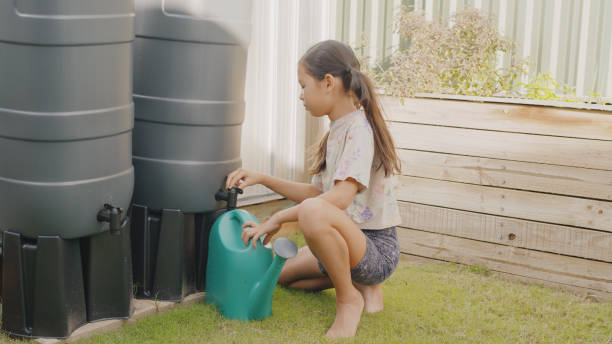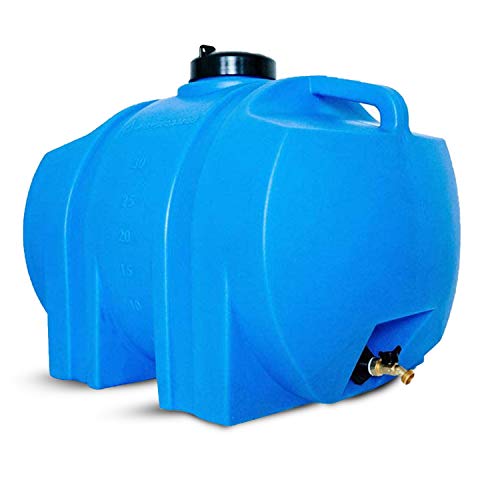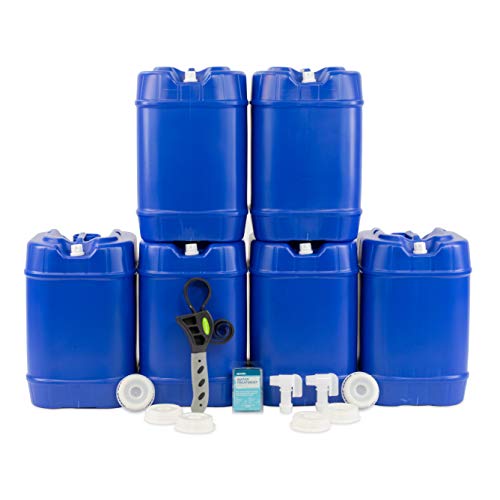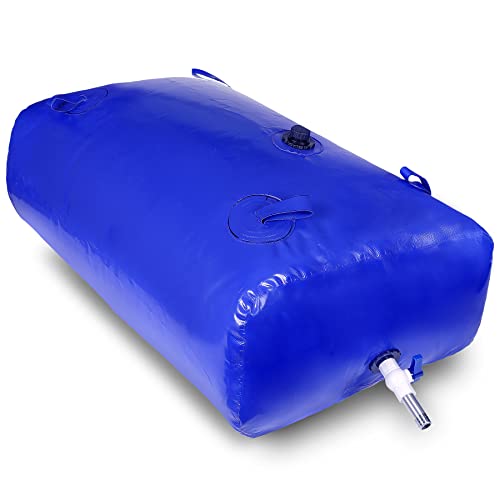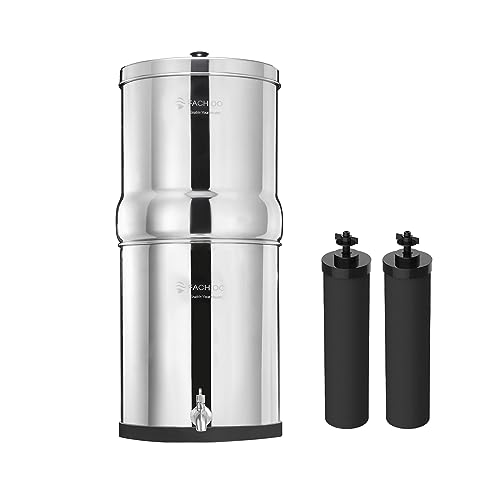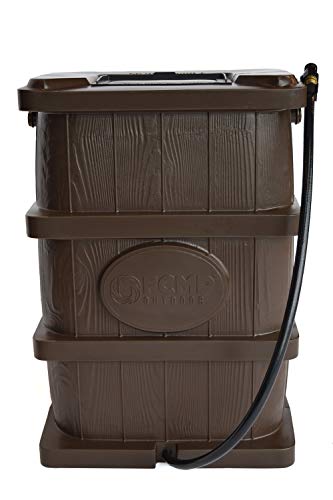- Flowers & PlantsVegetablesOur content is meticulously curated through independent research, testing, reviews, and AI-driven recommendations, all designed to present you with the finest product choices. When you make a purchase through our links, it could result in us earning a commission.
The Best Water Storage Tanks: Researched and Reviewed
Last updated: Feb 23, 2024
A high-quality water storage tank can be used to water your garden, transport drinking water, put out fires, and more — so it's not an investment you should take lightly. Regardless of how you plan to use your water tank, you want to get one that lasts for a price that doesn't break the bank. If you want to make a smart choice but don't want to spend your valuable time researching all the available options, this guide is for you. We’ve researched and reviewed the most impressive water storage tanks of 2024. Whether you're looking to store water for emergency preparedness, irrigation, or any other reason, we have you covered.
- Best Overall: WaterSupply 35-Gallon Water Storage Tank Shop Now ➔
- Stackable Design: Emergency Water Storage Tank Shop Now ➔
- Most Portable: MXQMKL 29-Gallon Portable Water Storage Tank Shop Now ➔
- Best for Purified Water: Fachioo 2.25 Gallon Steel Water Storage Tank Shop Now ➔
- Best for Gardening: FCMP 45 Gallon Water Storage Tank Shop Now ➔
View all Contents- Water Storage Tank FAQs
- Is it possible to move a water storage tank?
- Can I use a water storage tank for drinking water?
- What size water storage tank do I need?
- What are water storage tanks used for?
- How should I maintain my water storage tank?
- What are the signs of a leaking water storage tank?
- Are there any safety precautions I should take with water storage tanks?
- Can I use rainwater with a water storage tank?
- What is the lifespan of a water storage tank?
- Related Reviews
Reviewing the Top Water Storage Tanks of 2024
Best Overall
This 35-gallon water storage tank from WaterSupply is a must-have for anyone in need of a durable and convenient solution for plant watering or disaster preparedness. Crafted with BPA-free material, this storage tank ensures the water remains clean and safe.
What sets it apart is its large lid, a feature that allows for easy filling and access. Not only does it hold a whopping 35 gallons, but it also scores high on space efficiency, thus providing longevity and cost-effectiveness. Its robust blue color is not just appealing but also plays a practical role in preserving the water’s freshness by blocking the sunlight. For all the above reasons, WaterSupply secures the top spot on our list for the best water storage tanks of 2023.
Pros
- Easily fits in various vehicles
- Large lid and hose spigot make it easy to use
- Made with durable, BPA-free HDPE material
Cons
- More expensive option
Key Features
- 35-gallon water capacity
- UV-resistant plastic material
- Large, easy-rotate tank cap
- High-density polyethylene (HDPE) construction
- BPA-free and FDA/NSF compliant
- Includes hose spigot and 5″ lid
Stackable Design
This set of six water storage tanks from Emergency Water Storage provides a whopping 30 gallons of storage, making it a godsend for survivalists, campers, or anyone who wants to be prepared.
Each of these tanks has a capacity of 5 gallons, and they come with lids, a spigot, and a water treatment solution. They’re made of food-grade material and are perfect for transporting, thanks to the portable and stackable design. Filling them up is a breeze, and they’re just as easy to use. But the real beauty of these water storage tanks lies in their durability. Made to survive the toughest conditions, these sturdy containers promise long-term water storage without any compromise on safety or cleanliness.
Pros
- Sturdy and durable design
- Stackable for easy storage
- Includes useful accessories
Cons
- Need to drill holes for spout usage
- Potential leakage if stored on side
Key Features
- 5-gallon heavy-duty plastic construction
- 3/4 Inch threaded opening
- Stackable with built-in handle
- Dark blue to prevent algae growth
- Comes with 8 lids, 2 spigots, purification kit
- BPA-Free, holds 30-day water supply for 1 person
Most Portable
These foldable, portable water storage tanks were designed to tackle droughts and prevent fires. With their easy-to-carry design and significant water storage capacity, they’re perfect for camping, hiking, or any adventure in the great outdoors. While other water storage tanks take up a lot of space and are bulky to carry and transport, these can be rolled up and easily stored away when not in use. It’s also made of super tough, durable PCV so you don’t have to worry about it wearing down anytime soon.
Pros
- Affordable price
- Durable with well-made seams
- Foldable and portable
Cons
- Not suitable for drinking water
Key Features
- Capacity of 110 L/29 gallons
- Double-sided PVC mesh fabric
- Environmental Adaptation temperature of -50~+60
- Outlet valve has a 25mm diameter
Best for Purified Water
This 2.25-gallon steel water storage tank from Fachioo is an efficient and reliable water storage solution. Offering a unique blend of function and design, it’s your best water purification backup, whether you’re at home or out exploring the great outdoors. This water storage tank isn’t just about storing water – it’s about ensuring every drop you drink is clean, fresh, and healthy.
The gravity-fed filter system includes two black purification filters that reduce up to 99% chlorine, giving you crisp, safe water with every sip. It also features a robust metal spigot, providing you with easy access to your filtered water whenever you need it. The water storage tank is NSF/ANSI 42 certified, a testament to its high-quality performance and safety standards. Be it for your daily hydration needs or as camping essential, the Fachioo water storage tank is a great choice if your priority is reliable drinking water.
Pros
- Purifiers remove 200+ typical contaminants
- Durable stainless steel design
- NSF-certified for clean drinking water
Cons
- Washers tend to loosen and cause leaks
Key Features
- NSF/ANSI 42 certified
- 25 gallons (8.5 L) capacity
- Effective against 200+ contaminants
- 304 food-grade stainless-steel housing
- Includes metallic faucet and non-slip stand
- Each pair of elements lasts up to 6,000 gallons
- Non-slip bottom design
Best for Gardening
FCMP’s Wood Grain 45-Gallon Rain Barrel was designed to mimic the aesthetic of a classic wooden barrel — however, this water storage tank is far from traditional when it comes to its features. What sets it apart is the slim-line design, perfect for places where a larger barrel may not fit. It’s the ideal companion for watering outdoor plants, nourishing gardens, and hydrating landscapes, all while promoting efficient water use.
If its massive 45-gallon capacity isn’t enough for your needs, you can buy more than one and link the spigots together until it’s large enough for you. The water storage tank’s large capacity, affordable price, and rustic appearance make it a great choice for gardening and landscaping needs.
Pros
- Easily connects to hoses
- Natural, rustic appearance
- Large capacity
Cons
- Water is not safe for drinking
Key Features
- Slim-line, traditional wooden barrel design
- Shallow depth with flat back for installation
- Corrosion-resistant debris screen included
- Child and pet-safe rib on the barrel top
- Side spigots for easy barrel linking
- Constructed of UV-inhibited, BPA-free polyethylene
Buying Guide: Water Storage Tanks
Not sure how to choose the right water storage container for you? Keep reading to find out the main considerations and factors to keep in mind when making your informed decision. Whether you’re looking to harvest rainwater for sustainable use, store emergency water supplies, or manage water resources, this guide will equip you with valuable information to navigate the many water storage tanks available. From materials and capacities to installation tips and maintenance advice, we’re here to empower you on your journey toward efficient and effective water storage solutions at home.
Water Tank Capacity
Determining the appropriate tank capacity is the first step when choosing a water storage tank. Consider your water usage needs, the size of your property, and any future expansion plans. Tanks come in various capacities ranging from small household tanks to large-scale industrial tanks. Think about the space where you plan to place the tank and the dimensions of the area where the tank will be installed. Ensure that the tank’s size and dimensions fit within those size limitations.
Water Tank Material
Water storage tanks are typically made from three primary materials. These include polyethylene, fiberglass, and steel. Polyethylene tanks are lightweight, durable, and resistant to rust. Fiberglass tanks offer excellent corrosion resistance, allowing them to withstand extreme weather conditions. Steel tanks are known for their strength and longevity though they require additional measures to prevent corrosion.
- Plastic: Plastic water storage tanks are very popular for several reasons. Because they are much lighter than their metal counterparts, they’re easier to transport and install. Compared to metal water tanks, plastic water tanks are a more cost-effective solution due to their lower price point and ease of installation. However, they may need replacing sooner than other materials due to potential deterioration or wear and tear over time if used extensively or in harsher conditions such as direct sunlight and extreme cold or heat exposure. As a result, they are best for short-term use or for anyone on a budget.
- Metal/Steel: Steel water storage tanks are best for anyone who’s very serious about their water storage needs. Steel water tanks typically have longer lifespans than plastic tanks due to their increased durability and corrosion resistance. Steel water tanks can last up to 30 years, while plastic water tanks may only last 5-10 years before needing replacement. For this reason, they are often chosen for industrial or commercial uses. Because they are so heavy-duty, they are also literally heavier, making them difficult to install on rooftops or transport from place to place as they require additional machinery or personnel for installation and transportation purposes.
Installation Requirements
Different water storage tanks have varying installation requirements. Some tanks can be easily installed by homeowners, while others require professional assistance. Consider the complexity of installation and related costs before making a decision. For example, steel tanks must be installed by a licensed contractor or installer. They require specialized equipment for lifting and must be properly anchored to ensure stability. On the other hand, plastic tanks may only require a few tools, such as a drill and leveler.
Maintenance Needs
Regular maintenance is necessary to ensure the longevity and optimal performance of your water storage tank. Look for tanks that are easy to clean, inspect, and maintain. Consider features such as access points, removable parts, and recommended maintenance schedules. It is essential to inspect and maintain your tank regularly to avoid costly repairs or replacements.
Steel water storage tanks require minimal maintenance, while plastic tanks may be prone to cracking or other damage over time. Be sure to read the manufacturer’s guidelines for proper care and maintenance of your tank. Additionally, consider if you will need to hire someone for regular cleaning and inspection of the tank or if this can be done yourself.
UV Resistance
The UV resistance of your water tank is important for tanks that will be exposed to sunlight, especially those in warmer climates. Look for a water storage tank with UV-resistant coatings or materials to guarantee it won’t crack, fade, or warp due to intense sun exposure. If your water storage tank will be exposed to sunlight, UV resistance is crucial to prevent degradation and water contamination. Ensure that the tank you choose has built-in UV resistance properties. Alternatively, make sure it is protected by an additional UV-resistant coating.
Water Tank Insulation
Insulation can help you regulate the water temperature inside the water storage tank. This can prevent freezing in colder climates and excessive heat in warmer environments. If temperature control is important for you, choose a water storage tank with insulation properties. You can also consider adding insulation materials. Some water tanks are made with an insulating material or layer to prevent heat loss and reduce energy costs. Consider insulation for a water storage tank that will be exposed to freezing temperatures. This is especially important if you plan on using the liquid in your tank for drinking water, as frozen water lines can burst and cause costly damage.
Water Pressure Rating
The pressure rating of a tank refers to the amount of pressure it can handle before breaking. Make sure you check your water system’s pressure requirements and choose a tank that can meet those needs. If a water storage tank is unable to withstand the pressures in your system, it could break under extreme conditions and cause serious damage. Additionally, if you plan on using water from your tank for drinking purposes, you should select a tank with a higher pressure rating to ensure the safety of your family.
Consider the pressure requirements of your water system and choose a tank with an appropriate pressure rating. Some uses may require tanks designed to withstand higher pressures, while others may have lower pressure demands.
Overflow and Drainage Options
Make sure you take overflow options into account when selecting a water storage tank. Make sure your tank has an appropriate outlet for draining and overflow that matches the capacity of your system. Alternatively, make sure the water storage tank can be easily customized to fit your specific needs. This will help to prevent dangerous flooding or spills from occurring if too much water is stored in the tank.
How Do You Plan To Use Your Water Tank?
Now possibly the most important question: what are you going to do with your water storage tank? Consider the specific purpose for your water tank when selecting one. Different tanks are designed for different uses and it is essential to make sure you choose the right kind of tank for your particular needs. If you plan on using the water tank for residential drinking water, then you should select a tank that has been specifically designed and approved for this use. However, if you plan on using the tank for irrigation or other non-potable applications, then you should select a polyethylene water storage tank that is designed to hold water safely. Additionally, it is important to make sure that the design of the water storage tank meets any local codes and regulations. Finally, make sure you can access and maintain the water tank in order to ensure its safety and longevity.
Water Storage Tank FAQs
Is it possible to move a water storage tank?
Yes, depending on the size and design of the tank, it may be possible to move it. However, moving a water storage tank can be challenging and requires proper equipment and expertise. It is advisable to consult with professionals and follow any guidelines provided by the tank manufacturer to ensure safe relocation.
Can I use a water storage tank for drinking water?
Yes, many water storage tanks are designed and approved for storing drinking water. It is important to ensure that the tank you choose meets the necessary standards and regulations for potable water storage.
What size water storage tank do I need?
The size of the water storage tank you need depends on what you need it for. Generally speaking, larger tanks are better for storing large quantities of water over extended periods of time, while smaller tanks may be more suitable for holding smaller amounts of water for shorter periods.
What are water storage tanks used for?
You can use water storage tanks in many different ways. For example, you could store water for emergencies, firefighting, camping, or irrigation.
How should I maintain my water storage tank?
You should regularly maintain your water storage container by cleaning the tank, checking for leaks, ensuring proper ventilation, and treating the water to prevent bacterial growth.
What are the signs of a leaking water storage tank?
Signs of a leak may include reduced water pressure, visible water pooling around the tank, damp spots, and increased water bills.
Are there any safety precautions I should take with water storage tanks?
Safety measures include securing the tank to prevent tipping, keeping the area around the tank clear, and ensuring proper ventilation to prevent buildup of potentially harmful gases.
Can I use rainwater with a water storage tank?
Yes, rainwater harvesting is a common use for water storage tanks. You'll need proper filtration and treatment systems to make the rainwater suitable for various uses.
What is the lifespan of a water storage tank?
Lifespan depends on the material, maintenance, and environmental conditions. Plastic tanks may last 10-20 years, while steel tanks can last longer with proper care.
Article Contributors
Read More About Garden Gate Review Team HereThe Garden Gate Review Team is a group of writers, editors, and gardeners, dedicated towards writing trustworthy product reviews that'll help you choose the best products for a beautiful garden and backyard.
Garden Gate is reader-supported: When you buy through links on our site, we may earn an affiliate commission. Artificial Intelligence (large language models) may have been used in the research and creation of the content.
Please reach out to aimperiapt@gmail.com with any questions regarding product testing or specific articles.
